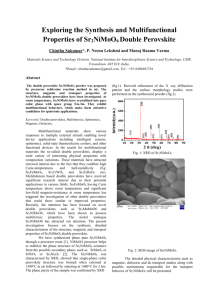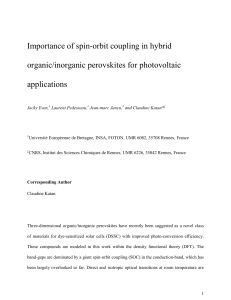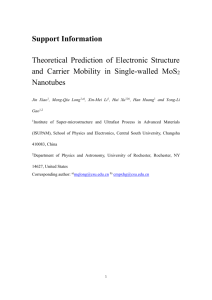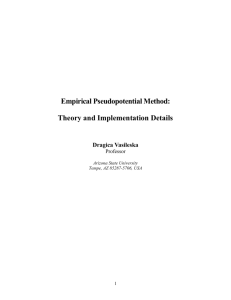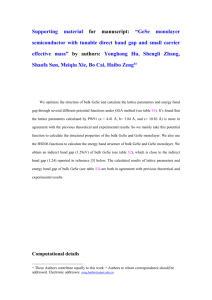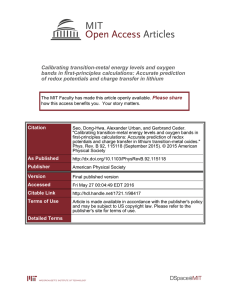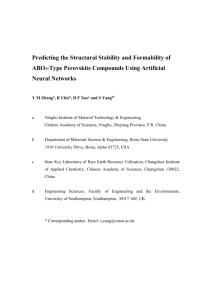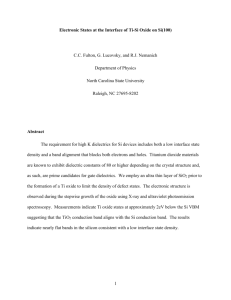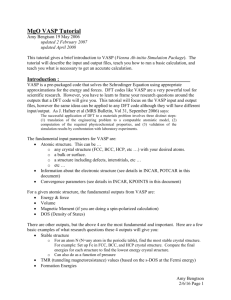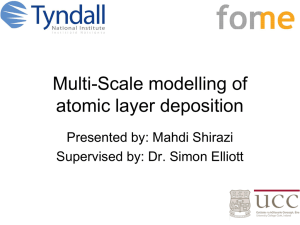Poster Presentation
advertisement
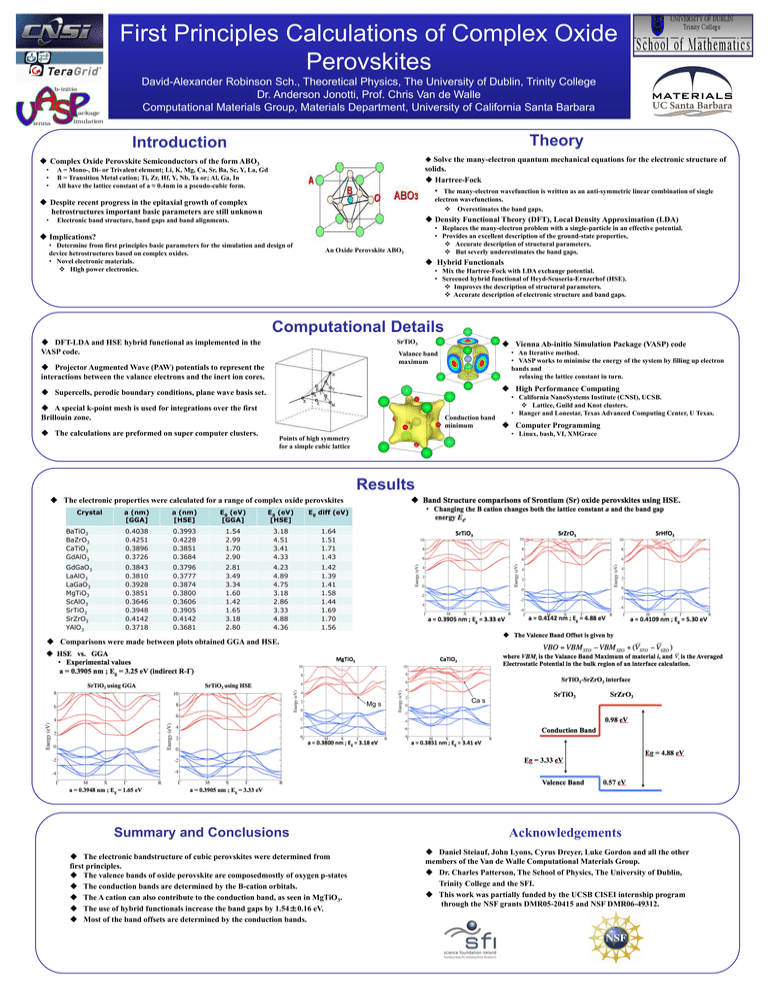
First Principles Calculations of Complex Oxide Perovskites David-Alexander Robinson Sch., Theoretical Physics, The University of Dublin, Trinity College Dr. Anderson Jonotti, Prof. Chris Van de Walle Computational Materials Group, Materials Department, University of California Santa Barbara Theory Introduction Solve the many-electron quantum mechanical equations for the electronic structure of Complex Oxide Perovskite Semiconductors of the form ABO3 • • • solids. Hartree-Fock • The many-electron wavefunction is written as an anti-symmetric linear combination of single A = Mono-, Di- or Trivalent element; Li, K, Mg, Ca, Sr, Ba, Sc, Y, La, Gd B = Transition Metal cation; Ti, Zr, Hf, Y, Nb, Ta or; Al, Ga, In All have the lattice constant of a ≈ 0.4nm in a pseudo-cubic form. electron wavefunctions. Overestimates the band gaps. Despite recent progress in the epitaxial growth of complex hetrostructures important basic parameters are still unknown • Density Functional Theory (DFT), Local Density Approximation (LDA) Electronic band structure, band gaps and band alignments. Implications? • Determine from first principles basic parameters for the simulation and design of device hetrostructures based on complex oxides. • Novel electronic materials. High power electronics. An Oxide Perovskite ABO3 • Replaces the many-electron problem with a single-particle in an effective potential. • Provides an excellent description of the ground-state properties, Accurate description of structural parameters. But severly underestimates the band gaps. Hybrid Functionals • Mix the Hartree-Fock with LDA exchange potential. • Screened hybrid functional of Heyd-Scuseria-Ernzerhof (HSE). Improves the description of structural parameters. Accurate description of electronic structure and band gaps. Computational Details DFT-LDA and HSE hybrid functional as implemented in the VASP code. SrTiO3 Vienna Ab-initio Simulation Package (VASP) code • An Iterative method. • VASP works to minimise the energy of the system by filling up electron bands and relaxing the lattice constant in turn. Valance band maximum Projector Augmented Wave (PAW) potentials to represent the interactions between the valance electrons and the inert ion cores. High Performance Computing Supercells, perodic boundary conditions, plane wave basis set. • California NanoSystems Institute (CNSI), UCSB. Lattice, Guild and Knot clusters. • Ranger and Lonestar, Texas Advanced Computing Center, U Texas. A special k-point mesh is used for integrations over the first Brillouin zone. The calculations are preformed on super computer clusters. Conduction band minimum Computer Programming • Linux, bash, VI, XMGrace Points of high symmetry for a simple cubic lattice Results The electronic properties were calculated for a range of complex oxide perovskites Crystal a (nm) [GGA] a (nm) [HSE] Eg (eV) [GGA] Eg (eV) [HSE] Eg diff (eV) BaTiO3 BaZrO3 CaTiO3 GdAlO3 0.4038 0.4251 0.3896 0.3726 0.3993 0.4228 0.3851 0.3684 1.54 2.99 1.70 2.90 3.18 4.51 3.41 4.33 1.64 1.51 1.71 1.43 GdGaO3 LaAlO3 LaGaO3 MgTiO3 ScAlO3 SrTiO3 SrZrO3 YAlO3 0.3843 0.3810 0.3928 0.3851 0.3646 0.3948 0.4142 0.3718 0.3796 0.3777 0.3874 0.3800 0.3606 0.3905 0.4142 0.3681 2.81 3.49 3.34 1.60 1.42 1.65 3.18 2.80 4.23 4.89 4.75 3.18 2.86 3.33 4.88 4.36 1.42 1.39 1.41 1.58 1.44 1.69 1.70 1.56 Comparisons were made between plots obtained GGA and HSE. Mg s Summary and Conclusions The electronic bandstructure of cubic perovskites were determined from first principles. The valence bands of oxide perovskite are composedmostly of oxygen p-states The conduction bands are determined by the B-cation orbitals. The A cation can also contribute to the conduction band, as seen in MgTiO3. The use of hybrid functionals increase the band gaps by 1.54±0.16 eV. Most of the band offsets are determined by the conduction bands. Ca s Acknowledgements Daniel Steiauf, John Lyons, Cyrus Dreyer, Luke Gordon and all the other members of the Van de Walle Computational Materials Group. Dr. Charles Patterson, The School of Physics, The University of Dublin, Trinity College and the SFI. This work was partially funded by the UCSB CISEI internship program through the NSF grants DMR05-20415 and NSF DMR06-49312.
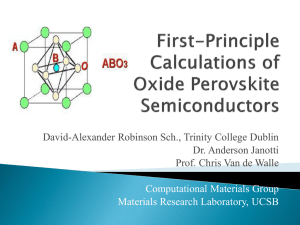



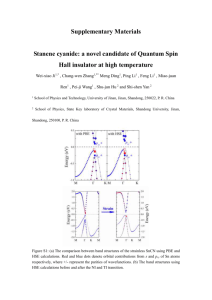

![Semiconductor Theory and LEDs []](http://s2.studylib.net/store/data/005344282_1-002e940341a06a118163153cc1e4e06f-300x300.png)


